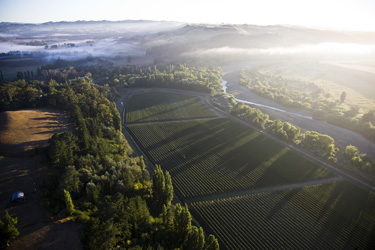Tony Bish was recently in Vancouver, but I was not, at the time.
He kindly sent along some wines, and articulated some answers to our questions about Sacred Hill.
How would you describe the climate in your region?
We grow mainly in two regions, Hawke's Bay and Marlborough. Hawke's Bay is a warm dry and sunny region on the East Coast of the North Island of New Zealand. We definitely have four seasons, with maximum daily temperatures varying from 8C to 35C. A cold morning in winter we may see a 5 degree frost, so quite warm winters compared to much of Canada. Marlborough is slightly more extreme in climate compared to Hawke's Bay, with greater diurnal (night to day) temperatures. This region also has very high sunshine hours, but more windy than Hawke's Bay.
Does it create any challenges in growing the fruit, and if so, please describe some of them.
Every season is different, especially as we are a maritime climate not continental. This means we get some real swings in weather, and often fairly unpredictable events. The main concerns in both regions are spring frosts and autumn rain events. Whilst we can fight frosts with wind machines and helicopters, it's much harder to deal with untimely rain events.
What rewards are reaped from growing in this climate? How do the wines reflect this?
Hawke's Bay has higher overall heat accumulation and higher daily maximums, so is well suited to growing varieties such as merlot, cabernet sauvignon and syrah. These reds we can physiologically ripen well, without excessive heat which can cause issues that some warmer countries must deal with. From cooler inland slightly elevated sites in Hawke's Bay, we produce NZ's finest Chardonnay. Marlborough with its high diurnal variation really suits sauvignon blanc and pinot noir. These varieties love that daily temperature swing, producing very intense varietal characters.
For the red wines, is getting to full ripeness achievable each vintage?
Yes it is in the case of our vineyards. In Hawke's Bay, we source all our red varieties from a world renowned sub-region known as the Gimblett Gravels. This is the heat epicenter of the region, and it is planted on very gravelly stony ground that is free draining and low in potential vine vigour. We are receiving significant international acclaim for the red wines from Gimblett Gravels.
Can you achieve the amazing lushness of the current Cab/Merlot each year?
As mentioned above, it is a combination of the right variety in the right soil type and sub-regional location, accompanied by very strict viticultural controls. We crop thin and manage our vine canopies to achieve maximum physiological maturity of fruit. This is followed by gentle handling in the winery, to make sure we do not over extract the tannins from the skins. Maturation in high quality French oak barriques adds complexity, power and balance.
Speaking of vintages, would you say there is significant variation year to year, or great consistency?
Definitely significant variation, but mainly within an acceptable band width. It is great that our wines reflect the seasons, or else they might become ubiquitous and boring!
The sauv blanc seems somewhat atypical of New Zealand, in that it has a certain raciness, with great balance, that reminds me of more Old World. Would you agree at all?
Yes I agree, I guess that is our goal to create stylish wines with as much complexity as possible, and in as unique a style as we can. There is a lot of good wine out there, but we need to stand out as being identifiably different in a very positive sense. Hopefully our wines reflect our soils, and our passion and creativity in winemaking.
In what ways does Sacred Hill typify great Hawkes Bay wines, and in what ways are they unique?
We typify great Hawke's Bay wines in that the wines have real purity of expression and elegance. They are unique in that we have our own sites and viticultural practice, and a strong sense of style and direction in the winery.
Can you describe the soil, the terroir, for Riflemans. How do you achieve such amazing length, and slight smokiness, with such great acidity and freshness?
This is a very special and totally unique vineyard site. It is an elevated river terrace, some 80 metres above a pristine river. The main base layer is known as papa rock, a kind of sand stone. Layered on top of this is 6-8 metres of very free draining highly aerated red gravels. This deep top layer is what the vines explore, and provides excellent physical properties. The site is slightly inland and elevated, so a bit cooler than the Gimblett Gravels which is more suited to ripening the red varieties. This combination of geography and geology seem to give us this amazing citrus fruit profile for chardonnay that also provides exceptional length of flavour. The acid balance is entirely natural, as is the winemaking technique. Truly a site expressive wine!
Any exciting new plantings and wines you wish to mention?
We have an exciting new wine style we will launch this year. Also from the Riflemans Terraces, we have produced a super-premium handpicked chardonnay that is not influenced by oak, which we are calling Virgin Chardonnay. As an analogy, it is somewhat akin to the Chablis style, although of course from a very different place and soil type! This wine is very floral, aromatic and fine, with a beautifully seamless precise palate, fresh acidity along with incredible drive and length.

 quicksearch
quicksearch






